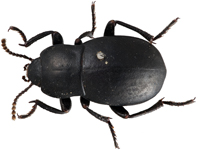Abstract
The study of immature stages in Pentatomidae contributes to the knowledge in several areas, mainly systematics, ecology and agriculture. In faunistic inventories, nymphs comprise a significant part of the specimens collected, which often cannot be identified due to lack of knowledge about the immature. Here, we describe the external morphology of eggs and nymphal stages of Runibia perspicua (Fabricius, 1798). The egg is barrel-shaped with the surface of chorium covered by spines, forming polygonal markings interconnected by sheets, similar as observed in some species of Carpocorini. In all the nymphal instars the abdomen is characterized by having rounded reddish spots and an orange/yellow longitudinal macula in the middle of each abdominal tergite, from abdominal segment II to VII. The first instar is the most distinctive, standing out mainly by the head and thorax totally brown. From the second instar the head and thorax acquire pale color with irregular brown spots. The labium presents significant variations in size along the ontogenetic development showing a non-isometric pattern, when compared to the total length of the body. Illustrations and photographs of all the immature stages and the detailed morphology of some structures in SEM are provided.
References
Brailovsky, H., Cervantes, L. & Mayorga, C. (1992) Hemiptera: Heteroptera de México. XLIV—Biología, estadios ninfales y fenologia de la tribu Pentatomini (Pentatomidae) en la Estación de Biología Tropical “Los Tuxtlas”, Veracruz. Publicaciones especiales del Instituto de Biología, UNAM, Nº 8, 9–204.
Brugnera, R. & Grazia, J. (2018) External morphology of immature of Tynacantha marginata Dallas, 1851 (Hemiptera, Heteroptera, Pentatomidae). Zootaxa, 4378 (1), 121–128.
https://doi.org/10.11646/zootaxa.4378.1.8
Botega, C.H., Bianchi, F.M. & Campos, L.A. (2015) Ontogeny of the dorsal abdominal gland external scent efferent system in Pentatomidae (Hemiptera: Heteroptera). Annals of the Entomological Society of America, 108 (4), 552–561,
https://doi.org/10.1093/aesa/sav052
Bunde, P.R.S., Grazia, J., Mendonça Junior, M.S., Schwertner, C.F., Ely e Silva, E.J. & Garcia, E.N. (2010) Pentatomidade (Hemiptera: Heteroptera) do Bioma Pampa: Serra do Sudeste e Parque Estadual do Espinilho, Rio Grande do Sul, Brasil. Biota Neotropica, 10, 83–88.
https://doi.org/10.1590/S1676-06032010000300008
De Clercq, P. (2000) Predaceous stinkbugs (Pentatomidae: Asopinae). In: Schaefer, C.W. & Panizzi, A.R. (Eds.), Heteroptera of Economic Importance. Cambridge University Press, Cambridge, pp. 737–789.
https://doi.org/10.1201/9781420041859.ch32
Grazia, J., Panizzi, A.R., Greve, C., Schwertner, C.F., Campos, L.A., de Garbelotto, T.A. & Fernandes, J.A.M. (2015) Stink Bugs (Pentatomidae). In: Panizzi, A.R. & Grazia, J. (Eds.), True Bugs (Hetereoptera) of the Neotropics. Springer, Dordrecht, pp. 681–756.
https://doi.org/10.1007/978-94-017-9861-7_22
Marsaro, A.L., Panizzi, A.R. & Lucini, T. (2017) Biology of a neotropical harlequin stink bug, Runibia perspicua (F.). Neotropical Entomology, 47 (6), 828–834.
https://doi.org/10.1007/s13744-017-0572-5
Matesco, V.C., Schwertner, C.F. & Grazia, J. (2007) Descrição dos estágios imaturos de Chinavia pengue (Hemiptera: Pentatomidae). Revista Brasileira de Entomologia, 51, 93–100.
https://doi.org/10.1590/S0085-56262007000100016
Matesco, V.C., Fürstenau, B.B.R., Bernardes, J.L.C., Schwertner, C.F. & Grazia, J. (2009). Morphological features of the eggs of Pentatomidae (Hemiptera: Heteroptera). Zootaxa, 1984 (1), 1–30.
https://doi.org/10.11646/zootaxa.1984.1.1
Matesco, V.C., Bianchi, F.M., Fürstenau, B.B.R., Pripook-da-Silva, P., Campos, L.A. & Grazia, J. (2014) External egg structure of the Pentatomidae (Hemiptera: Heteroptera) and the search for characters with phylogenetic importance. Zootaxa, 3768 (3), 351–385.
https://doi.org/10.11646/zootaxa.3768.3.5
Medeiros, L. & Megier, G.L. (2009) Ocorrência e desempenho de Euschistus heros (F.) (Heteroptera: Pentatomidae) em plantas hospedeiras alternativas no Rio Grande do Sul. Neotropical Entomology, 38 (4), 459–463.
https://doi.org/10.1590/S1519-566X2009000400003
Panizzi, A.R. (1997) Wild hosts of Pentatomidae from Africa, Madagascar and Mauritius (Hemiptera). Proceedings of the Royal Entomological Society of London, 34, 25–29.
https://doi.org/10.1111/j.1365-3113.1965.tb01644.x
Rider, D.A., Schwertner, C.F., Vilímová J., Rédei, D., Kment, P. & Thomas, D.B. (2018) Higher Systematics of the Pentatomoidea. In: McPherson, J.E. (Ed.), Invasive Stink Bugs and Related Species (Pentatomoidea). CRC Press, Boca Raton, Florida, pp. 26–201.
https://doi.org/10.1201/9781315371221-2
Schmidt, L.S. & Barcellos, A. (2007) Abundância e riqueza de espécies de Heteroptera (Hemiptera) do Parque Estadual do Turvo, sul do Brasil: Pentatomoidea. Iheringia, Série Zoologia, 97, 73–79.
https://doi.org/10.1590/S0073-47212007000100011
Schuh, R.T. & Slater, J.A. (1995) True bugs of the World (Hemiptera: Heteroptera): classification and natural history. Cornell University Press, Ithaca, 336 pp.
Vilímová, J. & Kutalová, K. (2012) Occurrence of certain cuticular structures confirms functionality of dorsal abdominal scent glands in Acanthosomatidae (Heteroptera: Pentatomoidea). Bulletin of Entomological Research, 102, 29–42.
https://doi.org/10.1017/S0007485311000344
Yonke, T.R. (1991) Order Hemiptera, In: Stehr, F.W. (Ed.), Immature insects. Kendall/Hunt Publishing Company, Dubuque, pp. 22–65.
Zwetsch, A. & Grazia, J. (2001) Revision of the genus Runibia (Heteroptera, Pentatomidae, Pentatomini). Iheringia Série Zoologia, 91, 5–28.
https://doi.org/10.1590/S0073-47212001000200001

